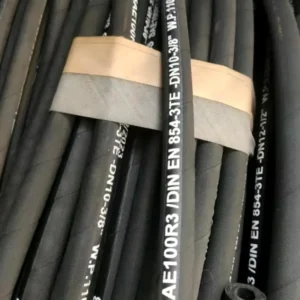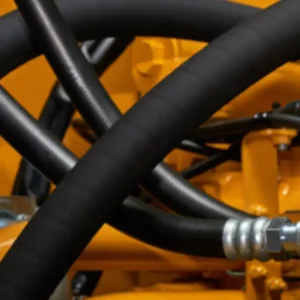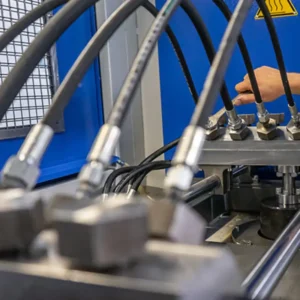As a trusted acetylene hose supplier, we’re often asked: Can acetylene hoses be repurposed for propane? While the temptation to save costs by reusing existing equipment is understandable, the answer requires a nuanced understanding of material science, safety standards, and real-world risks. In this guide, we’ll explore why mixing these hoses is unsafe and how to choose the right equipment for your propane applications.
Can Acetylene Hose Be Used for Propane
The primary reason to never mix these hoses is material incompatibility. The inner lining of an acetylene hose is specifically designed to resist the acetone that is used to stabilize the acetylene gas. However, propane gas contains different solvents that can cause this lining to degrade and break down over time. This can lead to a weakened hose, developing cracks, swelling, or pinhole leaks, which are all significant safety hazards.
Why Acetylene and Propane Hoses Are Different
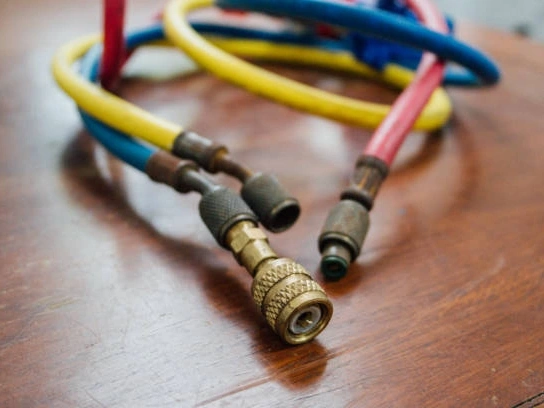
To truly understand why you can’t interchange these hoses, you need to look beyond their surface appearance. The differences are rooted in the very science and engineering behind their design. The materials used, the pressure ratings, and even the fittings are all tailored to the specific gas they are meant to transport.
- Chemical Composition and Material Compatibility: Acetylene is a highly reactive gas, particularly with copper. For this reason, acetylene hoses are made with a specific synthetic rubber that is non-reactive with it. Propane, on the other hand, is an oil-based hydrocarbon that can degrade the material in a hose designed for acetylene. The wrong gas can cause the hose’s inner lining to swell, crack, or become brittle over time, leading to leaks or a complete failure.
- Working Pressure and Certification: These hoses are manufactured to different pressure standards. While both are rated for high pressure, their specific certifications are tied to the type of gas they’re handling. For example, a hose designed for propane might have a different burst pressure and safety rating than one for acetylene. Using a hose outside its certified application is a direct violation of safety codes and puts you at risk.
- Fittings and Connections: Although fittings for fuel gases often use left-hand threads to prevent accidental connections with oxygen lines, there can still be subtle differences between acetylene and propane fittings. These subtle variations are a built-in safety feature designed to prevent you from even being able to make a connection that could be dangerous. Never force a fitting to connect, as this is a clear sign that the equipment is not compatible.
The Dangers of Using the Wrong Hose
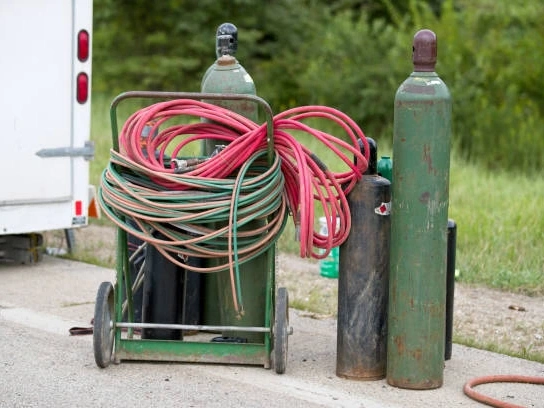
Ignoring the clear warning against using a hose for an unintended gas is taking a gamble with your life and livelihood. The risks are not theoretical; they are very real and can have devastating consequences.
Hose Degradation and Failure: As mentioned, the wrong chemical exposure can cause the hose material to break down. This degradation can lead to tiny, hard-to-detect leaks that can fill a workspace with gas, creating an invisible bomb. In a worst-case scenario, the hose could rupture under pressure, releasing a torrent of highly flammable gas.
Gas Leaks and Fire: A compromised hose or an ill-fitting connection is the number one source of gas leaks. Propane is heavier than air and will pool in low-lying areas, while acetylene is lighter. Regardless, a leak in either system can be ignited by a spark from your work, a nearby heat source, or even static electricity, causing a severe fire or explosion.
Compliance and Liability: Workplace safety regulations and industry standards are in place for a reason. Using the wrong hose is a direct violation of these codes. In the event of an accident, you could face severe legal liability, not to mention the loss of your tools, your business, or your health.
What Are the Correct Hose Colors and Types?
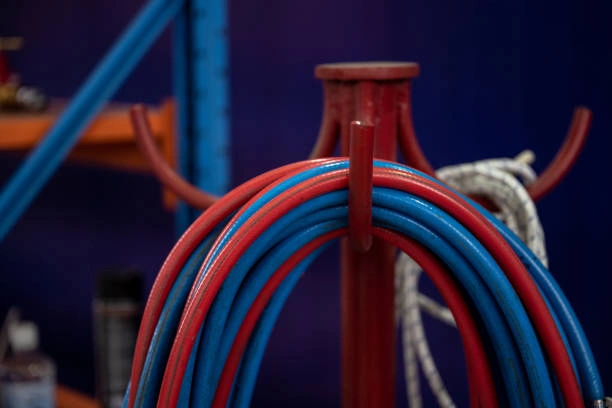
The best way to avoid a dangerous mix-up is to be familiar with the correct equipment. Every professional should know the industry’s color-coding system by heart. It’s the easiest and fastest way to ensure you’re using the right hose for the right gas.
| Gas Type | Correct Hose Color | Key Characteristics |
| Acetylene | Red | Designed for acetylene gas; non-reactive inner tube; left-hand threaded fittings. |
| Propane / LPG | Orange | Designed for propane/LPG; durable, oil-resistant outer cover; often with a different fitting style. |
| Oxygen | Green or Blue | Designed for oxygen; high-pressure rating; right-hand threaded fittings for safety. |
| Inert Gas (e.g., Argon) | Black | Designed for inert gases; often used for MIG/TIG welding shielding gas. |
Best Practices for Hose Safety
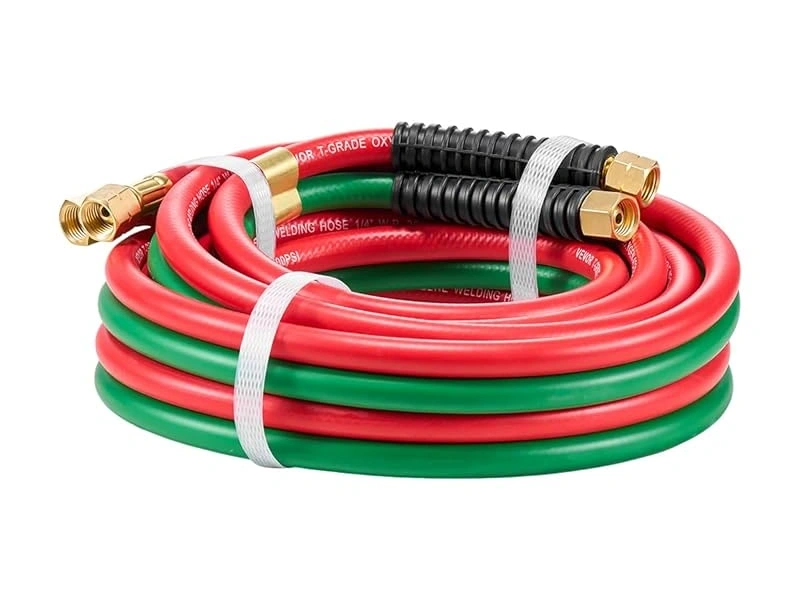
Knowing what to do is just as important as knowing what not to do. By following a few simple best practices, you can ensure your hoses remain in top condition and your work environment stays safe.
- Always Check the Label: The color is the first clue, but the label is the proof. Always check the markings on the hose itself to confirm it is rated for the specific gas you are using.
- Inspect Regularly: Before every use, perform a visual inspection of your hoses. Look for cracks, cuts, burns, or soft spots. Use a leak-detecting solution to check fittings.
- Store Properly: Store hoses coiled neatly in a cool, dry place away from direct sunlight, chemicals, and hot surfaces. Never leave them on the ground where they can be damaged or run over.
- Never Force a Connection: If a fitting doesn’t thread on easily, it’s not the right fitting. Stop and identify the correct components.
- Replace on Schedule: Hoses degrade over time. Follow the manufacturer’s recommended replacement schedule, typically every 1-5 years, even if the hose looks fine.
What Type of Hose Can Be Used for Propane?
For propane applications, you must use a hose that is specifically designed and certified for propane gas. These hoses are made from materials that can safely handle the chemical makeup and pressure of propane without degrading.
The most common types of propane hoses are constructed with a nitrile rubber or thermoplastic inner tube. These materials are highly resistant to the chemical degradation that propane can cause, preventing the hose from swelling, cracking, or developing dangerous pinhole leaks.
These hoses also have a specific pressure rating that makes them suitable for the higher pressures of propane, compared to other gases like natural gas. For added durability and protection against abrasions, many propane hoses are also covered with a braided stainless steel or synthetic yarn reinforcement.
Conclusion
Acetylene hoses should absolutely not be used with propane. The risk is simply not worth it. In the world of welding, safety isn’t optional; it’s a necessity. By understanding the key differences between these hoses, adhering to the industry’s color-coding system, and practicing good maintenance habits, you can protect yourself and those around you. Always use the right tools, especially when they are your lifeline.

